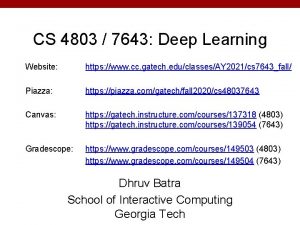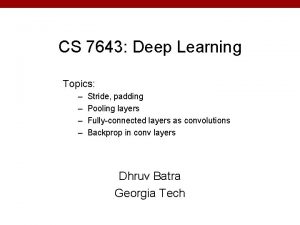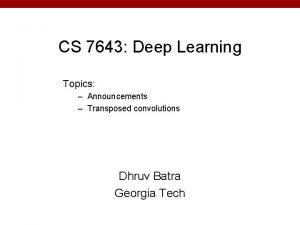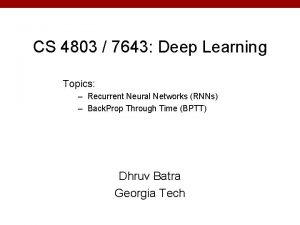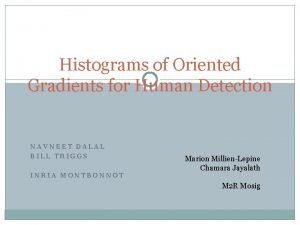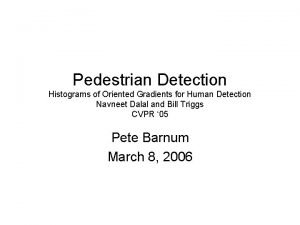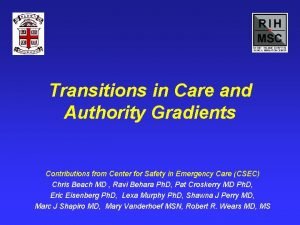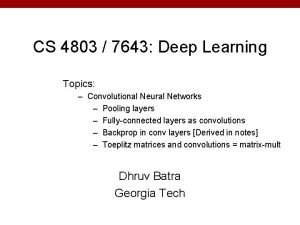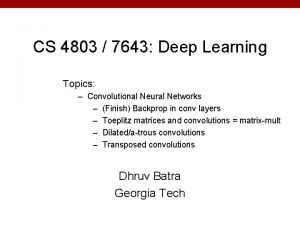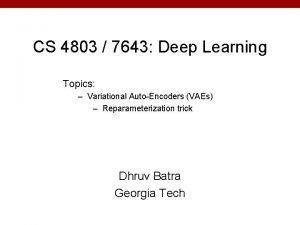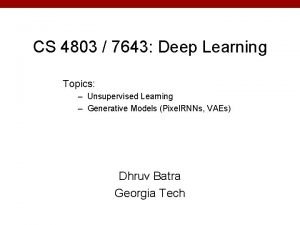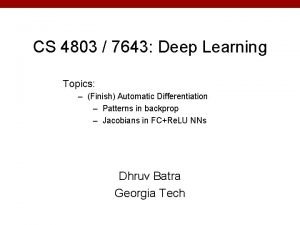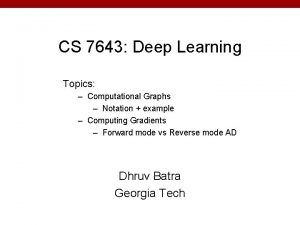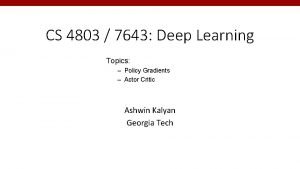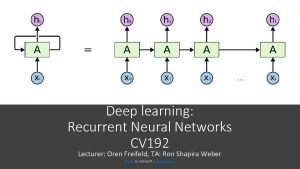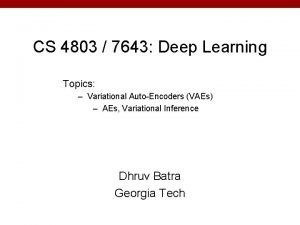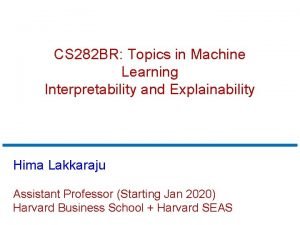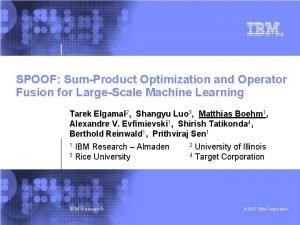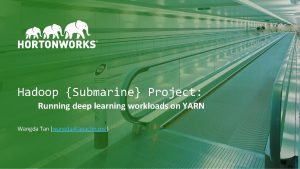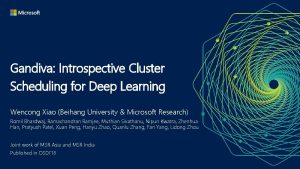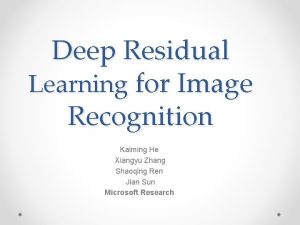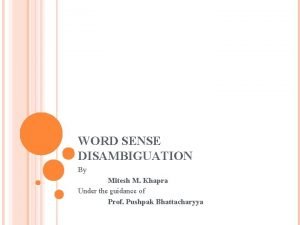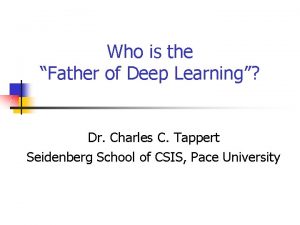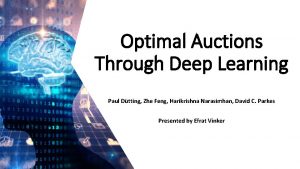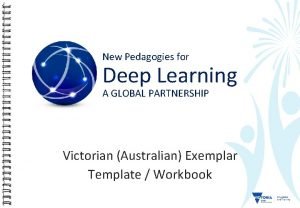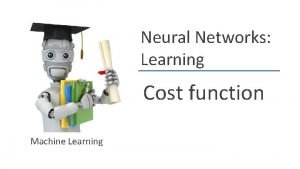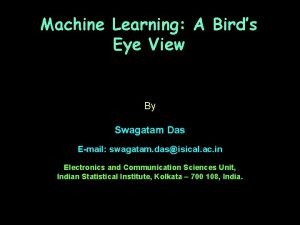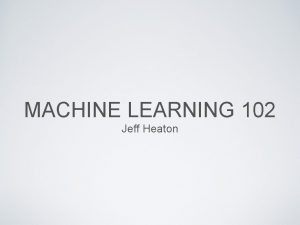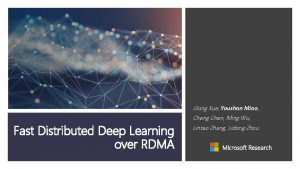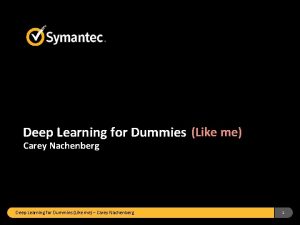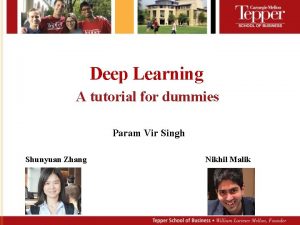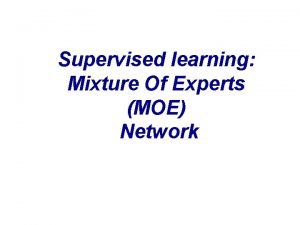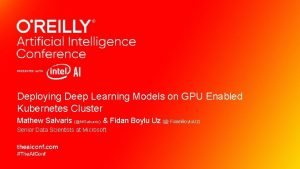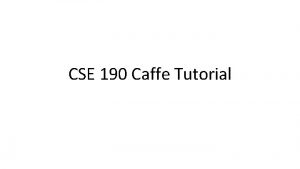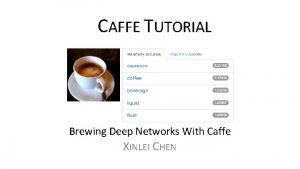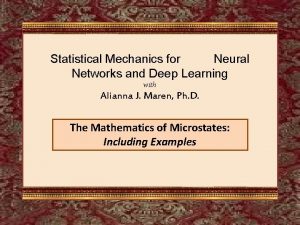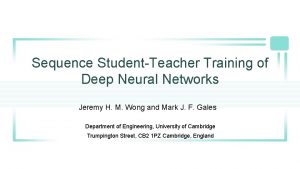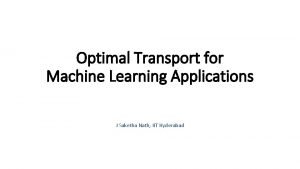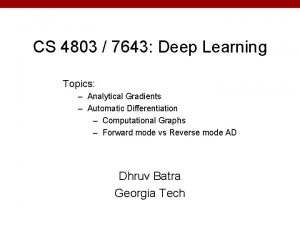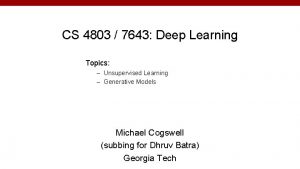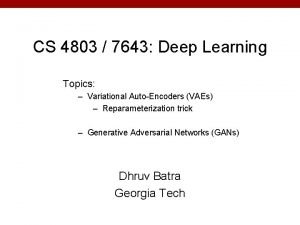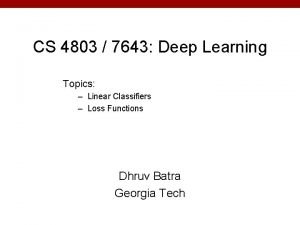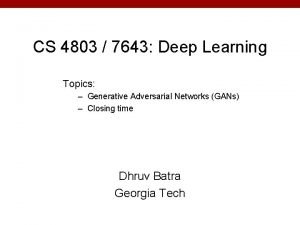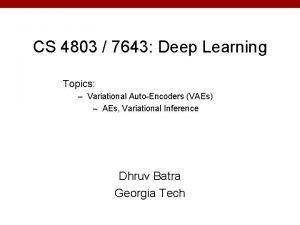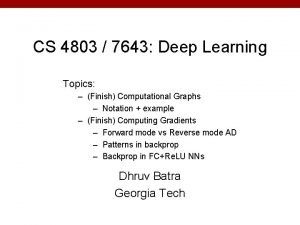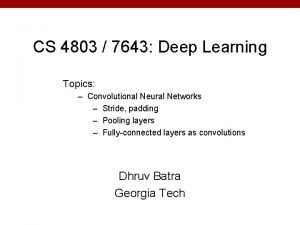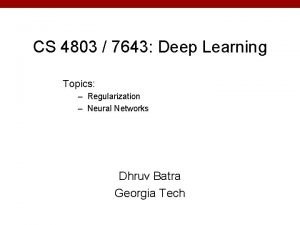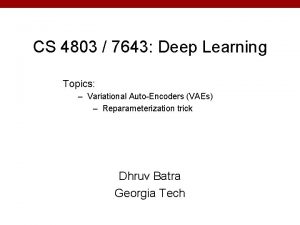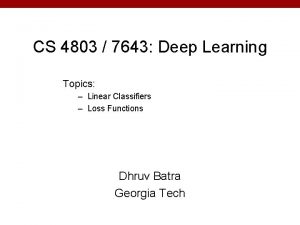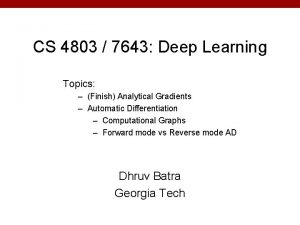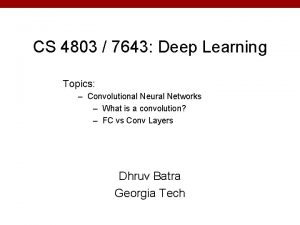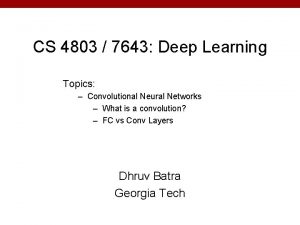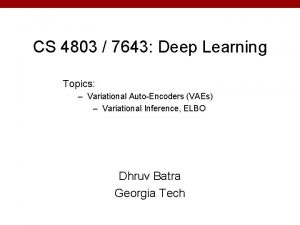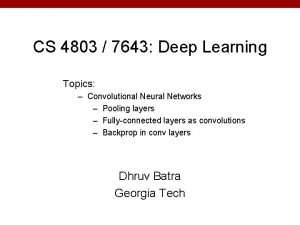CS 4803 7643 Deep Learning Topics Policy Gradients



















































- Slides: 51

CS 4803 / 7643: Deep Learning Topics: – Policy Gradients – Actor Critic Ashwin Kalyan Georgia Tech

Topics we’ll cover • Overview of RL • RL vs other forms of learning • RL “API” • Applications • Framework: Markov Decision Processes (MDP’s) • Definitions and notations • Policies and Value Functions • Solving MDP’s • Value Iteration (recap) • Q-Value Iteration (new) • Policy Iteration • Reinforcement learning • Value-based RL (Q-learning, Deep-Q Learning) • Policy-based RL (Policy gradients) • Actor-Critic 2

Recap: MDPs • Markov Decision Processes (MDP): • States: • Actions: • Rewards: • Transition Function: • Discount Factor: 3

Recap: Optimal Value Function The optimal Q-value function at state s and action a, is the expected cumulative reward from taking action a in state s and acting optimally thereafter 4

Recap: Optimal Value Function The optimal Q-value function at state s and action a, is the expected cumulative reward from taking action a in state s and acting optimally thereafter Optimal policy: 5

Recap: Learning Based Methods • Typically, we don’t know the environment • unknown, how actions affect the environment. • unknown, what/when are the good actions? 6

Recap: Learning Based Methods • Typically, we don’t know the environment • unknown, how actions affect the environment. • unknown, what/when are the good actions? • But, we can learn by trial and error. • Gather experience (data) by performing actions. • Approximate unknown quantities from data. 7

Recap: Deep Q-Learning • Collect a dataset • Loss for a single data point: Predicted Q-Value Target Q-Value • Act according optimally according to the learnt Q function: Pick action with best Q value 8

Getting to the optimal policy known Transition function and reward function Use value / policy iteration Obtain “optimal” policy 9

Getting to the optimal policy known Use value / policy iteration Transition function and reward function Obtain “optimal” policy unknown Estimate Q values From data Previous class: Q - learning 10

Getting to the optimal policy known Transition function and reward function Use value / policy iteration Estimate and from data Obtain “optimal” policy unknown Estimate Q values From data Homework! 11

Getting to the optimal policy known Transition function and reward function Use value / policy iteration unknown Estimate and from data Obtain “optimal” policy unknown Estimate Q values From data This class! 12

Learning the optimal policy • Class of policies defined by parameters • Eg: can be parameters of linear transformation, deep network, etc. 13

Learning the optimal policy • Class of policies defined by parameters • Eg: can be parameters of linear transformation, deep network, etc. • Want to maximize: • In other words, 14

Learning the optimal policy • Class of policies defined by parameters • Eg: can be parameters of linear transformation, deep network, etc. • Want to maximize: • In other words, 15

Learning the optimal policy • Slightly rewriting the notation: • Let , the trajectory 16

Learning the optimal policy Sample a few trajectories by acting according to 17

REINFORCE 1. Sample trajectories 2. Compute policy gradient as by acting according to 3. Update policy Run the policy and sample trajectories Slide credit: Sergey Levine Compute policy gradient Update policy 18

Policy Gradients Expand expectation 19

Policy Gradients Expand expectation Exchange integration and expectation 20

Policy Gradients Expand expectation Exchange integration and expectation 21

Policy Gradients Expand expectation Exchange integration and expectation 22

Policy Gradients Expand expectation Exchange integration and expectation 23

Policy Gradients Expand expectation Exchange integration and expectation 24

Policy Gradients 25

Policy Gradients Doesn’t depend on Transition probabilities! 26

Policy Gradients 27

Policy Gradients 28

REINFORCE 1. Sample trajectories 2. Compute policy gradient as by acting according to 3. Update policy Run the policy and sample trajectories Slide credit: Sergey Levine Compute policy gradient Update policy 29

Pong from pixels Image Credit: http: //karpathy. github. io/2016/05/31/rl/ 30

Pong from pixels Image Credit: http: //karpathy. github. io/2016/05/31/rl/ 31

Pong from pixels Image Credit: http: //karpathy. github. io/2016/05/31/rl/ 32

Intuition (C) Dhruv Batra 33

Policy Gradients Formalizes notion of “trial and error”: • If reward is high, probability of actions seen is increased • If reward is low, probability of actions seen is reduced 34

Issues with Policy Gradients • Credit assignment is hard! • Which specific action led to increase in reward • Suffers from high variance leading to unstable training 35

Issues with Policy Gradients • Credit assignment is hard! • Which specific action led to increase in reward • Suffers from high variance leading to unstable training • How to reduce the variance? • Subtract a constant from the reward! 36

Issues with Policy Gradients • Credit assignment is hard! • Which specific action led to increase in reward • Suffers from high variance leading to unstable training • How to reduce the variance? • Subtract a constant from the reward! • Why does it work? • What is the best choice of b? Homework! 37

Taking a step back Policy Evaluation (Recall Policy iteration) • REINFORCE: Evaluate and update policy based on Monte-Carlo estimates of the total reward – very noisy! • Other ways of policy evaluation? • If we had the Q function, we could have used it! 38

Actor-Critic • Learn both policy and Q function • Use the “actor” to sample trajectories • Use the Q function to “evaluate” or “critic” the policy 39

Actor-Critic • Learn both policy and Q function • Use the “actor” to sample trajectories • Use the Q function to “evaluate” or “critic” the policy • REINFORCE: • Actor-critic: 40

Actor-Critic • Learn both policy and Q function • Use the “actor” to sample trajectories • Use the Q function to “evaluate” or “critic” the policy • REINFORCE: • Actor-critic: • Q function is unknown too! Update using 41

Actor-Critic • Initialize s, (policy network) and (Q network) 42

Actor-Critic • Initialize s, (policy network) and (Q network) • sample action 43

Actor-Critic • Initialize s, (policy network) and (Q network) • sample action • For each step: • Sample reward and next state 44

Actor-Critic • Initialize s, (policy network) and (Q network) • sample action • For each step: • Sample reward and next state • evaluate “actor” using “critic” 45

Actor-Critic • Initialize s, (policy network) and (Q network) • sample action • For each step: • Sample reward and next state • evaluate “actor” using “critic” and update policy: 46

Actor-Critic • Initialize s, (policy network) and (Q network) • sample action • For each step: • Sample reward and next state • evaluate “actor” using “critic” and update policy: • Update “critic”: • Recall Q-learning 47

Actor-Critic • Initialize s, (policy network) and (Q network) • sample action • For each step: • Sample reward and next state • evaluate “actor” using “critic” and update policy: • Update “critic”: • Recall Q-learning • Update • Accordingly 48

Actor-critic • In general, replacing the policy evaluation or the “critic” leads to different flavors of the actor-critic • REINFORCE: • Q – Actor Critic 49

Actor-critic • In general, replacing the policy evaluation or the “critic” leads to different flavors of the actor-critic • REINFORCE: • Q – Actor Critic • Advantage Actor Critic: “how much better is an action than expected? 50

Summary • Policy Learning: • Policy gradients • REINFORCE • Reducing Variance (Homework!) • Actor-Critic: • Other ways of performing “policy evaluation” • Variants of Actor-critic 51
 Cs 7643 deep learning
Cs 7643 deep learning Pooling stride
Pooling stride Cs 7643 deep learning
Cs 7643 deep learning Cs 7643 deep learning
Cs 7643 deep learning Histograms of oriented gradients for human detection
Histograms of oriented gradients for human detection Pressure gradients in the heart
Pressure gradients in the heart Histograms of oriented gradients for human detection
Histograms of oriented gradients for human detection Authority gradients
Authority gradients Cs 4803
Cs 4803 Cs 4803
Cs 4803 Cs 4803
Cs 4803 Cs 4803
Cs 4803 Cs 4803
Cs 4803 Cs 7643 project
Cs 7643 project Cs 7643 github
Cs 7643 github Lstm colah
Lstm colah Cs 7643
Cs 7643 Cmu machine learning
Cmu machine learning Tony wagner's seven survival skills
Tony wagner's seven survival skills Deep asleep deep asleep it lies
Deep asleep deep asleep it lies Deep forest towards an alternative to deep neural networks
Deep forest towards an alternative to deep neural networks 深哉深哉耶穌的愛
深哉深哉耶穌的愛 Cuadro comparativo e-learning b-learning m-learning
Cuadro comparativo e-learning b-learning m-learning Cs 282
Cs 282 Global citizenship education topics and learning objectives
Global citizenship education topics and learning objectives Operator fusion deep learning
Operator fusion deep learning Lstm andrew ng
Lstm andrew ng Hadoop deep learning
Hadoop deep learning Gandiva: introspective cluster scheduling for deep learning
Gandiva: introspective cluster scheduling for deep learning Deep residual learning for image recognition
Deep residual learning for image recognition Deep learning speech recognition
Deep learning speech recognition Autoencoders
Autoencoders Supervised vs unsupervised learning
Supervised vs unsupervised learning Mitesh khapra
Mitesh khapra Frank rosenblatt
Frank rosenblatt Dtting
Dtting Deep learning competencies 6 c's
Deep learning competencies 6 c's Cost function in neural network
Cost function in neural network Bird eye view deep learning
Bird eye view deep learning Jeff heaton deep learning
Jeff heaton deep learning Jilong xue
Jilong xue Deep learning dummies
Deep learning dummies Shunyuan zhang
Shunyuan zhang Moe deep learning
Moe deep learning Xkcd artificial intelligence
Xkcd artificial intelligence Intel deep learning training tool
Intel deep learning training tool Kubernetes gpgpu
Kubernetes gpgpu Caffe tutorial
Caffe tutorial Caffe deep learning tutorial
Caffe deep learning tutorial Statistical mechanics of deep learning
Statistical mechanics of deep learning Student teacher deep learning
Student teacher deep learning Ioslides
Ioslides
